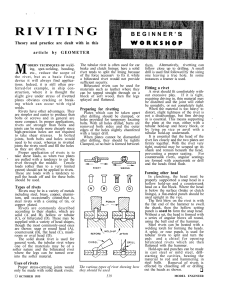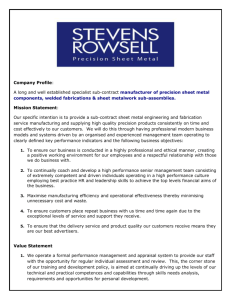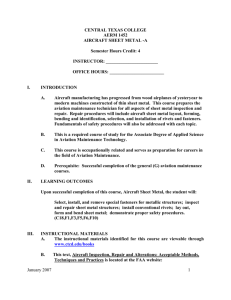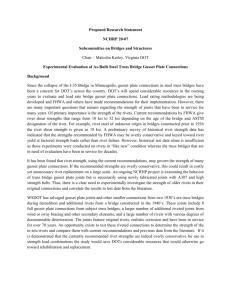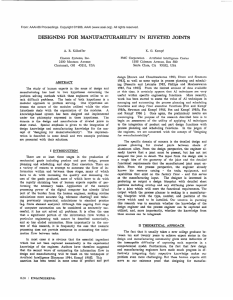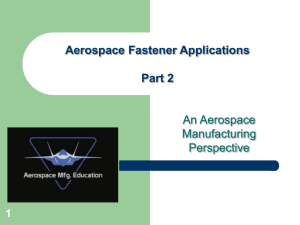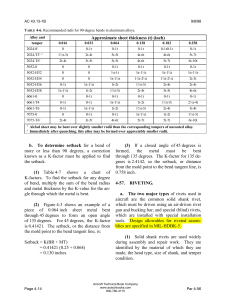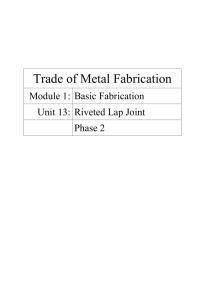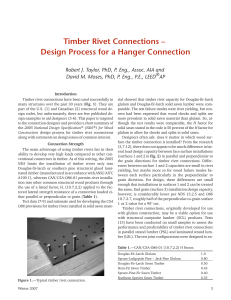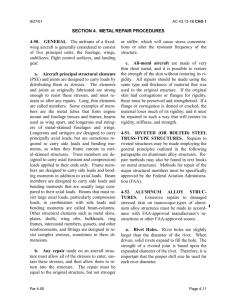course name - Tulsa Tech
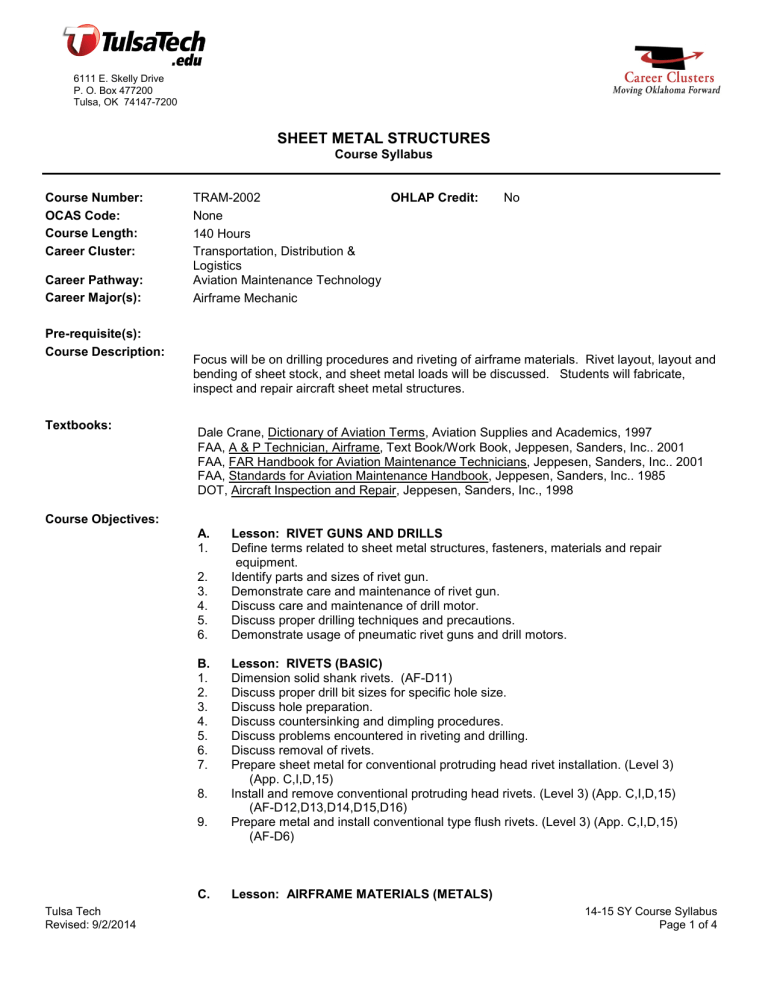
6111 E. Skelly Drive
P. O. Box 477200
Tulsa, OK 74147-7200
Course Number:
OCAS Code:
Course Length:
Career Cluster:
Career Pathway:
Career Major(s):
Pre-requisite(s):
Course Description:
SHEET METAL STRUCTURES
Course Syllabus
OHLAP Credit: No TRAM-2002
None
140 Hours
Transportation, Distribution &
Logistics
Aviation Maintenance Technology
Airframe Mechanic
Focus will be on drilling procedures and riveting of airframe materials. Rivet layout, layout and bending of sheet stock, and sheet metal loads will be discussed. Students will fabricate, inspect and repair aircraft sheet metal structures.
Textbooks:
Course Objectives:
Tulsa Tech
Revised: 9/2/2014
Dale Crane, Dictionary of Aviation Terms, Aviation Supplies and Academics, 1997
FAA, A & P Technician, Airframe, Text Book/Work Book, Jeppesen, Sanders, Inc.. 2001
FAA, FAR Handbook for Aviation Maintenance Technicians, Jeppesen, Sanders, Inc.. 2001
FAA, Standards for Aviation Maintenance Handbook, Jeppesen, Sanders, Inc.. 1985
DOT, Aircraft Inspection and Repair, Jeppesen, Sanders, Inc., 1998
A. Lesson: RIVET GUNS AND DRILLS
1. Define terms related to sheet metal structures, fasteners, materials and repair
equipment.
2. Identify parts and sizes of rivet gun.
3. Demonstrate care and maintenance of rivet gun.
4. Discuss care and maintenance of drill motor.
5. Discuss proper drilling techniques and precautions.
6. Demonstrate usage of pneumatic rivet guns and drill motors.
B. Lesson: RIVETS (BASIC)
1. Dimension solid shank rivets. (AF-D11)
2. Discuss proper drill bit sizes for specific hole size.
3. Discuss hole preparation.
4. Discuss countersinking and dimpling procedures.
5. Discuss problems encountered in riveting and drilling.
6. Discuss removal of rivets.
7. Prepare sheet metal for conventional protruding head rivet installation. (Level 3)
(App. C,I,D,15)
8. Install and remove conventional protruding head rivets. (Level 3) (App. C,I,D,15)
(AF-D12,D13,D14,D15,D16)
9. Prepare metal and install conventional type flush rivets. (Level 3) (App. C,I,D,15)
(AF-D6)
C. Lesson: AIRFRAME MATERIALS (METALS)
14-15 SY Course Syllabus
Page 1 of 4
SHEET METAL STRUCTURES
Tulsa Tech
Revised: 9/2/2014
1. Discuss types of materials used.
2. Discuss advantages and disadvantages of aluminum.
3. Discuss advantages and disadvantages of magnesium.
4. Interpret sheet stock nomenclature.
5. Interpret sheet stock composition.
6. Discuss aluminum strength characteristics, advantages and disadvantages.
7. Discuss alloying elements for aluminum.
8. Discuss heat treatable and non heat treatable aluminum.
9. Explain how to determine condition of stressed skin structure that is known to have been
critically loaded.
10. Identify the code designations for heat treatable alloys.
D. Lesson: RIVETS (ADVANCED)
1. Identify head style and part numbers of rivets.
2. Explain rivet coding system.
3. Discuss rivet composition and materials.
4. Explain ice box rivets and describe temperature and time.
5. Discuss stresses that rivets are designed to resist.
6. Determine shear strength, bearing strength, bearing failure and shear failure.
7. Determine proper rivet length and diameters. (Level 3) (App. C,I,D,15)
8. Determine cleco sizes and colors to be used with rivet sizes and diameters.
9. Explain precautions concerning rivet fit.
E. Lesson: RIVET LAYOUT
1. Explain edge distance
2. Explain spacing and transverse pitch.
3. Explain general repair procedure for elongated rivet holes.
4. Discuss corrosion prevention methods for rivets.
F. Lesson: LAYOUT AND BENDING OF FLAT SHEET STOCK
1. Define bend radius.
2. Discuss checking radius sizes.
3. Discuss factors determining radius sizes.
4. Define parts of a bend.
5. Introduce formulas for finding bend allowance.
6. Explain set back and its use.
7. Explain sight line.
8. Explain layout for bends other than 90
Ε
.
9. Discuss formation of a joggle.
10. Explain layout of metal across verses along the grain.
11. Explain purpose and location of bend relief holes.
12. Form, layout, and bend sheet metal. (Level 3) (App. C,I,D,16) (AF- D17,D18,D19)
G. Lesson: SHOP EQUIPMENT
1. Discuss proper use of shop equipment used in forming sheet metal.
2. Demonstrate proper use of shop equipment used in forming sheet metal.
3. Discuss hand forming of sheet metal.
4. Fabricate a lap joint assembly using procedures for joining dissimilar metals.
(Level 3) (App. C,I,D,15; E16)
5. Fabricate a bent-up type stringer. (Level 3) (App. C,I,D,15; E16)
H. Lesson: SHEET METAL STRUCTURAL LOADING
1. Identify loads and stresses acting on aircraft structures.
2. Identify primary and secondary structural parts.
14-15 SY Course Syllabus
Page 2 of 4
SHEET METAL STRUCTURES
Teaching Methods:
3. Identify non structural parts.
I. Lesson: SHEET METAL REPAIRS
1. Identify the basic requirement for all structural repairs.
2. Explain the general requirements for obtaining the basic requirement.
3. Explain the difference between a major and a minor repair.
4. Determine the number of rivets needed for a structural repair. (Level 3)
(App. C,I,D,14,15) (AF-D5,D20)
5. Discuss skin patches.
6. Discuss crack repairs by stop drilling.
7. Discuss stringer repairs.
J. Lesson: UNCONVENTIONAL FASTENERS
1. Identify blind rivets.
2. Identify rivnuts.
3. Discuss huck bolts
4. Discuss Hi-Lok fasteners.
5. Discuss Jo-bolts.
6. Discuss hi-shear pin rivets.
7. Fabricate a sheet metal box and install rivnuts (deicer boot fasteners). (Level 3)
(App. C,I,D,10,15; E16)(AF-D1,D3)
9. Repair a stressed skin structure. (Level 3) (App. C,I,D,14,15)(Gen. E11,E14,E12)
(App. C,I,D,10,15; E16)(AF-D2)
8. Construct a sheet metal structure using unconventional fasteners. (Level 3)
The class will primarily be taught by the lecture and demonstration method and supported by various media materials to address various learning styles. There will be question and answer sessions over material covered in lecture and media presentations. Supervised lab time is provided for students to complete required projects.
Grading Procedures:
1. Students are graded on theory and shop practice and performance.
2. Each course must be passed with seventy (70%) percent or better.
3. Grading scale: A=90-100%, B=80-89%, C=70-79%, F=0-69%.
Description of
Classroom,
Laboratories, and
Equipment:
Available
Certifications/
College Credit
Tulsa Technology Center campuses are owned and operated by Tulsa Technology Center
School District No. 18. All programs provide students the opportunity to work with professionally certified instructors in modern, well-equipped facilities.
The student may be eligible to take state, national or industry exam after completion of the program. College credit may be issued from Oklahoma State University-Okmulgee or Tulsa
Community College. See program counselor for additional information.
Tulsa Tech
Revised: 9/2/2014
14-15 SY Course Syllabus
Page 3 of 4
SHEET METAL STRUCTURES
College Credit
Eligibility:
The student must maintain a grade point average of 2.0 or better.
Tulsa Tech
Revised: 9/2/2014
14-15 SY Course Syllabus
Page 4 of 4


